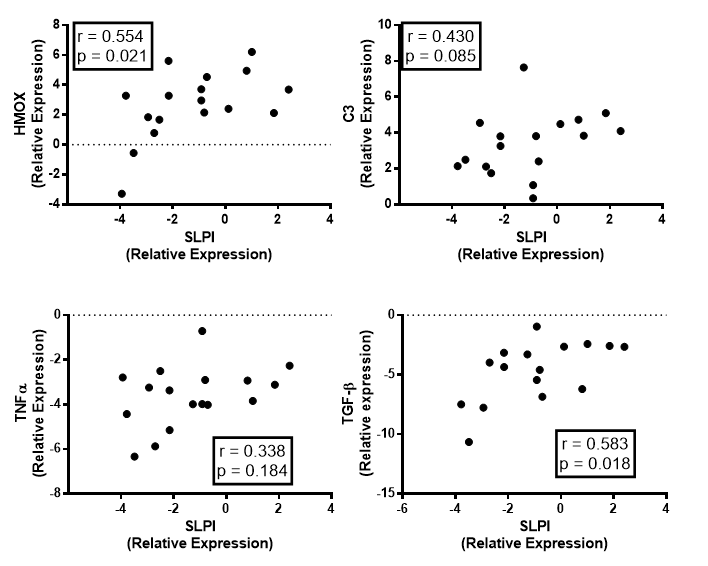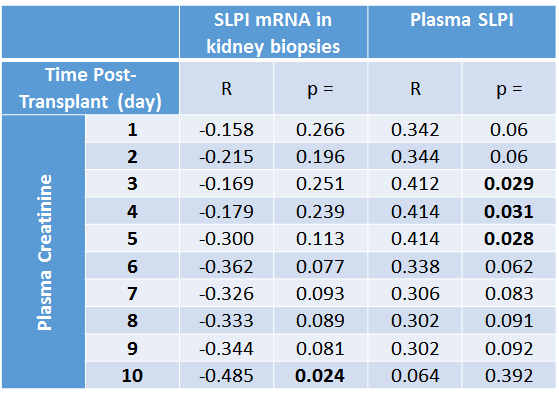SLPI Expression on Kidney Biopsies Correlates with Better Clinical Outcomes
Nella Ambrosi1, Fiorella Caro1, Diego Guerrieri1, Leonardo Díaz-Alvarez2, Fernanda Toniolo2, Pablo Uva2, Claudio Incardona3, Domingo Casadei2, Eduardo Chuluyan1,2.
1CEFYBO, Facultad de Medicina, UBA-CONICET, Buenos Aires, Argentina; 2Instituto de Nephrologia, Nephrology, Buenos Aires, Argentina; 3Fundacion GADOR, Buenos Aires, Argentina
Secretory leukocyte protease inhibitor (SLPI) is a serine protease inhibitor produced mainly by epithelial cells. It has been described that SLPI could be a biomarker for acute kidney injury. However, we have described that SLPI has a protective role on epithelial kidney cells and favors the immunossupresive activity by decreasing lymphocyte cell proliferation. Moreover, we found that plasma levels of SLPI is high in transplant patient and there is an indirect correlation with renal function. We hypothetized that local levels of SLPI but not plasma levels of SLPI has a nephrotective activity. Therefore, the aim of the present study was to assess the expression of SLPI on kidney biopsies at the time of transplantation and to correlate the expression of it with other inflammatory markers and clinical outcomes. The study included 18 kidney biopsies obtained at the end of the surgery of transplant patients. We evaluated the transcripts levels of SLPI and others factors that are usually associated with tissue injury (such as C3 and TNF-α) or protection (as TGF-β and HMOX-1) by RT-qPCR. Figure 1A shows that there is a direct correlation between the levels of the SLPI transcript and HMOX-1 or TGF-β but not with C3 or TNF-α, suggesting that SLPI present in the graft, could be related to genes linked to cytoprotection and anti-inflammatory mediators.  To determine if these results had a clinical impact, we next evaluated the relationship between SLPI transcript levels at the time of biopsy and creatinine levels during the first 10 days post-transplant. Table 1 shows that tissue SLPI transcript levels correlated indirectly with plasma creatinine values, in particular at day 10 post-transplant, suggesting the existence of an association between local SLPI transcript levels and a better short-term renal function.
To determine if these results had a clinical impact, we next evaluated the relationship between SLPI transcript levels at the time of biopsy and creatinine levels during the first 10 days post-transplant. Table 1 shows that tissue SLPI transcript levels correlated indirectly with plasma creatinine values, in particular at day 10 post-transplant, suggesting the existence of an association between local SLPI transcript levels and a better short-term renal function.  Remarkably, there was not a correlation between tissue SLPI mRNA and plasma levels of SLPI measured at day 1 post-transplant. However, a direct correlation was observed between plasma level of SLPI (meassured at day 1) and the creatinine levels of the first days post-transplant (Table 1).
Remarkably, there was not a correlation between tissue SLPI mRNA and plasma levels of SLPI measured at day 1 post-transplant. However, a direct correlation was observed between plasma level of SLPI (meassured at day 1) and the creatinine levels of the first days post-transplant (Table 1).
Overall, these results suggest that local SLPI could have a nephrotective activity while plasma levels of SLPI may reflect a kidney injury.
ANPCYT PICT2014-2504. UBACYT2014-2017. Fundación del 3er Milenio. Fundación GADOR.
